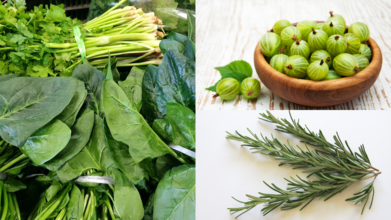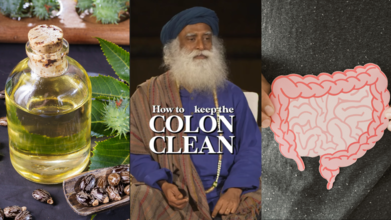- Health Conditions A-Z
- Health & Wellness
- Nutrition
- Fitness
- Health News
- Ayurveda
- Videos
- Medicine A-Z
- Parenting
- Web Stories
Stay Cool Naturally: Ayurvedic Foods To Balance Your Body This Summer

Credit: Canva
As temperatures soar during summer, it is not just sunburns and sweat we need to worry about. Our internal balance could be affected too. According to Ayurveda, an ancient system of natural healing, summer is the season of pitta dosha, a bio-energy composed of fire and water elements. When this dosha becomes aggravated, it can lead to symptoms like skin rashes, acidity, indigestion, irritability, and even emotional outbursts.
But the food we eat can play a powerful role in restoring balance. Ayurvedic wisdom offers simple dietary choices to help cool the body and soothe the mind—without necessarily relying on cold drinks or air conditioning. Here is what you should know.
Choose Cooling Over Cold
Ayurveda teaches that cooling foods are always cold in temperature—they have a cooling energy, explains Lauren Gernady of the Kripalu School of Ayurveda. Think cucumbers, melons, and leafy greens—not necessarily chilled but naturally pacifying to pitta.Hydrate The Ayurvedic Way
Staying well-hydrated is key, but plain water isn't your only option. Coconut water with a squeeze of lime is highly recommended by Ayurvedic practitioner Larissa Hall Carlson. This refreshing drink helps replenish electrolytes and balances internal heat.
Leafy Greens And Seasonal Fruits
Foods with bitter and astringent tastes help regulate pitta. Leafy greens such as spinach, kale, watercress, and arugula are ideal. Seasonal fruits like watermelon, cantaloupe, and berries also help calm the body’s heat while offering essential hydration and nutrients.
Avoid Heat-Generating Foods
To stay in balance, experts advise avoiding pitta-aggravating foods like fried, oily, overly salty, spicy dishes, and processed or canned items. Even common kitchen staples like onions and garlic can stir up pitta, says Erin Casperson, former Dean of the Kripalu School of Ayurveda.
Herbs That Heal And Cool
Adding fresh herbs to your meals is another easy way to stay cool. Mint, cilantro, and basil not only bring refreshing flavor but also carry anti-inflammatory and detoxifying properties. “These herbs contain volatile oils and flavones, which are powerful phytonutrients,” notes nutritionist Annie B. Kay. A homemade cilantro-mint chutney is a delicious way to incorporate these into your diet.
Think Twice Before Reaching For Iced Coffee
While iced coffee may seem like the perfect summer pick-me-up, it could do more harm than good. “Caffeine is both stimulating and dehydrating,” warns Hilary Garivaltis, Executive Director of the National Ayurvedic Medical Association. She recommends switching to herbal teas instead. And if you must have your drink on ice, allow it to sit a bit—too much cold can dampen digestion, a key concern in Ayurveda.
DIY Cooling Spice Blend
To enhance your meals while keeping your inner thermostat in check. You can try this Ayurvedic spice mix for the same.
3 tbsp cumin seeds
3 tbsp coriander seeds
2 tbsp fennel seeds
2 tbsp ground turmeric
Dry-roast the whole seeds over medium-low heat until fragrant, then add turmeric and roast for 30 seconds. Let cool, grind, and store in an airtight jar. Sprinkle over fruit, yoghurt, or veggies.
Eat Your Way to Lush Locks: 4 Ayurvedic Food Groups That Boost Hair Growth

If your hairbrush has been collecting more strands than you would like to admit, your plate might be the problem. According to Ayurvedic health coach Dimple Jangda, the secret to thicker, shinier, stronger locks doesn’t lie in a pricey serum but in your kitchen. “Four food groups… prevent hair loss and promote hair growth. You must definitely have this at home,” she says. And she’s not talking about exotic, hard-to-pronounce superfoods; these are humble, accessible ingredients that can transform your hair from limp to lush.
1. Greens
Dimple champions greens like spinach and moringa as hair saviours. Spinach is more than a side salad staple — it’s loaded with iron, folate, vitamin A and vitamin C. Moringa, often called the ‘drumstick tree’, is an Ayurvedic darling packed with vitamins A, B, and E, zinc and iron.
“Both of them help in stimulating hair growth,” says Dimple, explaining that they also boost the production of hair sebum, the scalp’s natural oil that keeps hair hydrated and protected. In other words, leafy greens are basically your hair’s in-house moisturiser.
Tip: Add spinach to your morning smoothie or sauté moringa leaves with a dash of ghee for a side dish that doubles as a beauty treatment.
2. Seeds
Next on Dimple’s list are seeds. Pumpkin seeds deliver zinc and other fatty acids, while flax seeds are famous for their omega-3 content. They help in improving the hair strength and reducing hair loss and hair breakage, according to Dimple.
Sprinkle a spoonful of flax seeds over yoghurt, blend them into your smoothie, or toss pumpkin seeds into your salad for an easy hair boost.
3. Vitamin C-Rich Foods
When Dimple talks about vitamin C, she’s not thinking about orange juice alone. She recommends sweet peppers and amla (Indian gooseberry) as top picks. Both are rich in vitamin C, which she says helps in reducing oxidative stress in your body, stimulating hair growth.
Oxidative stress is like rust for your cells and yes, that includes your hair follicles. Keeping it at bay ensures healthier growth and less shedding.
Tip: Snack on sweet pepper slices with hummus or chew on fresh amla if you can handle its tangy punch. You could also sip amla juice in the morning for a daily hair tonic.
4. Rosemary
Finally, Dimple calls rosemary the most powerful of the four. It contains rosmarinic acid, which she says can be consumed or applied. “You can make a rosemary tea and drink every day or you can make a concoction of rosemary, castor and coconut oil, apply it on your scalp and rinse it off after an hour,” she explains. This helps stimulate new hair growth and may even prevent baldness.
Making rosemary tea feels like a mini self-care ritual. The steam alone is soothing. As for the oil blend, it’s basically a spa treatment for your scalp.
Beyond the Plate
While these four food groups can work wonders from the inside, Dimple reminds us that holistic care makes the magic happen. Staying hydrated, avoiding excess caffeine, and massaging your scalp with oils infused with bhringraj, brahmi or coconut can further boost blood circulation and strengthen follicles.
Herbal masks made with hibiscus, fenugreek and shikakai soothe the scalp and encourage fresh growth, while daily stress-relief practices like pranayama, gentle yoga and mindful eating can help you keep your mane in peak condition.
‘Drink Castor Oil To Cleanse Your Colon,’ Says Sadhguru, But Science Isn’t Convinced

Credits: Canva and Instagram
Recently, spiritual guru Sadhguru sparked curiosity by recommending a traditional practice from Southern India: drinking half a spoon of warm castor oil mixed in water or milk every night.
According to him, this keeps the colon clean and activates the lymphatic system.
But is there any science behind this nightly ritual?
We spoke to Edwina Raj, Head of Services, Clinical Nutrition & Dietetics at Aster CMI Hospital, Bangalore, to decode the facts.
Castor Oil: Traditional Remedy or Gut Dependency?
Castor oil has been used in Ayurvedic and traditional medicine for years as a natural remedy for constipation. But does that mean it’s safe or effective for daily use?
“Castor oil is approved by the US Food and Drug Administration (FDA), as a stimulant laxative, and modern science sees it mainly as a short-term solution for constipation,” says Raj. She cautions that using it daily, even in small amounts, can lead to dependence. “Your gut may start relying on it to function, which could eventually disrupt natural digestion and bowel movements.”
In essence, while it may help occasionally, frequent use might do more harm than good. “For long-term gut health, it’s better to focus on a high-fiber diet, adequate water intake, regular physical activity, and probiotic-rich foods.”
Morning or Night? When’s the Right Time?
Sadhguru suggested consuming castor oil at night, but nutrition experts aren’t fully convinced about the timing.
“There is a lack of clinical evidence supporting the best time to take castor oil,” Raj notes. “Castor oil typically starts working within 2 to 6 hours, so taking it late in the evening could disturb your sleep.”
She adds that consuming it right after a heavy meal could cause nausea or stomach discomfort. “It’s best taken occasionally and in small amounts, never self-administered regularly without expert advice,” she emphasizes.
Can Everyone Digest Castor Oil? Not Quite
While some people may tolerate castor oil, not everyone’s digestive system can handle it smoothly.
“People with IBS, ulcers, or other sensitive gut issues may experience cramping, bloating, nausea, or diarrhea,” Raj warns. “It stimulates the intestines, which can be harsh for vulnerable digestive systems.”
What’s more, castor oil is derived from Ricinus communis, a plant that contains a toxic compound called ricin. “Although ricin is mostly removed during oil processing, the plant’s laxative effect can interfere with absorption of other medications,” she adds.
Pregnant women should also avoid it. “Castor oil may induce premature labor contractions and is not recommended for those with inflammatory bowel conditions like Crohn’s or colitis.”
Beyond a Laxative: Are There Other Benefits?
Ayurveda often promotes castor oil as a multi-functional remedy, but what does modern science say?
“Ricinoleic acid in castor oil does have anti-inflammatory and antimicrobial properties,” Raj explains. “But these are primarily beneficial when used externally, such as in castor oil packs for skin or joint pain.”
When ingested, especially on a regular basis, the risks may outweigh the benefits. “There is limited scientific evidence supporting long-term internal use of castor oil for general wellness.” So while ancient wisdom gives it a prominent role, it must be used with caution in modern-day routines.
Is It Safe to Consume Castor Oil Long-Term?
This is where things get tricky. While some believe a small daily dose is harmless, experts are wary.
“Long-term use, even in small doses, can lead to dependency, electrolyte imbalance, and nutrient malabsorption,” Raj warns. Diarrhea from overuse can deplete vital minerals like potassium and magnesium, leading to fatigue, dizziness, and dehydration.
She adds, “The gut may lose its natural motility, and your body may struggle to process nutrients efficiently. This could have serious consequences over time.”
Use Occasionally, and With Guidance
While Sadhguru’s recommendation draws from age-old traditions, it’s crucial to differentiate between cultural practices and evidence-based health strategies.
“Castor oil should be used as an occasional remedy, not a daily habit,” Raj concludes. “Always consult a doctor or nutritionist before adding it to your routine, especially if you have underlying conditions.”
In short, if you’re seeking better gut health, your best bet still lies in fiber, hydration, movement, and mindful eating—not in relying on nightly shots of castor oil.
Disclaimer: This article is intended for informational purposes only and should not be considered medical advice. Always consult your healthcare provider before starting any new supplement or treatment.
Tired, Bloated, Achy? Try These Safe And Effective Ayurvedic Detox Rituals During Rainy Season

Credits: Health and me
The monsoon known as Varsha Ritu or Karkidakam in Ayurveda isn’t just a seasonal shift. It’s nature’s nudge for us to slow down, recalibrate, and cleanse. While rains bring relief from summer heat, they also usher in humidity, dampness, and a spike in seasonal illnesses. According to ancient Ayurvedic wisdom, this transitional weather phase is when the body is most receptive to detoxification—if done with care.
The monsoon season might feel like the perfect time to curl up and indulge, but according to Ayurveda, this is actually the time your body craves a reset. Why? Because the sudden drop in temperature and rise in moisture throw your internal balance off-kilter—aggravating digestion, joints, skin, and immunity.
So, instead of pushing through the sluggishness with more caffeine or sugar, what if you gave your body exactly what it needs—a gentle, nourishing detox that clears the fog without draining your energy?
“Unlike summer, when the body is already exhausted by heat, the rainy season brings a sudden atmospheric shift that aggravates Vata dosha,” says Dr. Rohit Sane, Ayurvedic physician and CEO of Madhavbaug. “This imbalance is at the root of joint pain, indigestion, fatigue, and even respiratory discomfort.”
A detox during the rains must focus on cleansing without depletion. The goal is to reset your system gently—nourishing while eliminating.
Why Rainy Season Upsets the Body's Balance?
In Ayurveda, health is defined by the balance of three doshas: Vata (air), Pitta (fire), and Kapha (water). During monsoon, all three tend to get aggravated, throwing the body’s internal ecosystem off-kilter.
Vata aggravation affects the nervous and musculoskeletal system. Think joint pain, stiffness, sciatica, or lower back issues.
Pitta dosha flares up, targeting the skin, liver, and digestion. You might notice acne, acidity, or heat-related rashes.
Kapha imbalance causes congestion, bloating, and fluid retention. Respiratory infections, asthma, and sinus flare-ups are common.
“All three doshas being in flux at the same time makes this season unique. This is why the OPDs are full. Patients show up with everything from arthritis flare-ups to gut issues,” explains Dr. Sane.
Ayurvedic Approach to Seasonal Cleansing
Rather than crash diets or juice cleanses, Ayurveda emphasizes slow, sustainable, and constitutional detox rituals that remove Ama (toxins) while preserving Ojas—your vital energy.
1. Fasting to Rest the Gut
One of the most recommended practices during monsoon is light fasting. Especially during the month of Shravan, fasting helps the gastrointestinal system recover from inflammation and toxic buildup.
“Fasting allows the body to shift its focus from digestion to elimination,” notes Dr. Sane. “Even intermittent fasting or skipping one meal a day can offer significant relief to the GI tract.”
Choose easy-to-digest foods on eating days—think moong dal soups, rice porridge, or lightly spiced buttermilk.
2. Hydration with Intention
Waterborne infections are common during this season. Ayurveda encourages boiling water with cleansing herbs like ginger or cumin, then cooling it to room temperature before drinking.
“Always purify or boil water in this season,” warns Dr. Sane. “Contaminated water introduces toxins, which defeat the purpose of detox.”
Herbal teas and warm decoctions also support liver and kidney function, essential for internal cleansing.
3. Snehan and Swedan- Oil and Steam Therapy
The Ayurvedic duo of Snehan (oleation therapy) and Swedan (steam therapy) is especially effective during Varsha Ritu. Oil massage using warm, medicated oils calms Vata, nourishes joints, and hydrates the skin. Followed by herbal steam, the body sweats out deep-seated toxins.
“These are not just spa treatments,” says Dr. Sane. “They are therapeutic interventions. The oil pulls out fat-soluble toxins, and the steam opens up the skin’s pores to expel them.”
Regular sessions during the monsoon help reduce joint inflammation, improve circulation, and boost immunity.
4. Basti Therapy- Colon Cleanse for Vata Balance
If there’s one treatment Ayurveda considers the crown jewel of detox, it’s Basti, or medicated enemas. Especially important during Vata aggravation, Basti cleanses the colon—the seat of Vata dosha.
“Basti helps in eliminating deep-rooted toxins that no other therapy can reach. It also restores gut health, boosts nutrient absorption, and calms the mind,” explains Dr. Sane.
Under the supervision of a qualified Ayurvedic practitioner, Basti can be personalized using herbal oils or decoctions based on the individual’s constitution.
Gentle Daily Habits for Monsoon Well-Being
You don’t have to check into an Ayurvedic clinic to benefit from monsoon detox. A few mindful practices at home can go a long way:
- Wake up early and start your day with warm lemon water or ginger tea.
- Avoid cold, raw foods that dampen digestive fire (Agni). Opt for steamed or sautéed seasonal vegetables.
- Wear breathable cotton clothing and keep your feet dry to avoid fungal infections.
- Add spices like turmeric, cinnamon, and cumin to support digestion and immunity.
And perhaps most importantly, slow down. Ayurveda teaches that true healing happens when the body is in rest-and-digest mode—not while rushing through routines.
Detoxification is not a seasonal trend. It’s an ancient ritual of self-respect and maintenance—especially relevant in today’s toxic world. The rainy season, though often overlooked in Western wellness circles, is a golden opportunity to reset.
“Cleansing without depletion is the essence of Ayurvedic detox,” concludes Dr. Sane. “Done right, it restores balance, strengthens immunity, and sets the tone for sustained wellness through the rest of the year.” As the rain nourishes the earth outside, this is the time to cleanse gently, with wisdom—not to punish your body, but to honour it.
© 2024 Bennett, Coleman & Company Limited



